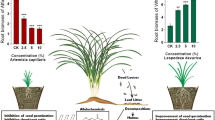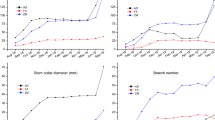Abstract
Black cherry (Prunus serotina Ehrh.) seedlings survive and grow poorly under dense hay-scented fern (Dennstaedtia punctilobula Michx.) ground cover in the understory of partially cut Allegheny hardwood stands. Previous field studies showed that there were about 80% fewer black cherry seedlings where fern was present than where it was absent. Allelopathic interference with black cherry seed germination, seedling survival, and growth by hay-scented fern foliage leachates, root washings, and soil transformation products was evaluated in a series of field, greenhouse, and laboratory experiments. Black cherry seeds germinated as well in the presence of hay-scented fern or its leachates as when they were absent in both the laboratory and the field. Fern foliage leachates and root washings did not affect black cherry growth in sand or natural soil cores in the greenhouse. There also was no evidence that hay-scented fern natural products or their soil transformation products built up in the soil. A two-year manipulative field experiment to separate effects of hay-scented fern foliage shade from foliar leaching showed that foliage shade significantly reduced black cherry seedling survival and growth; foliage leachates had no effect. Results of the studies led to the conclusion that allelopathy does not play a direct role in hay-scented fern interference with black cherry seedling establishment in partially cut Allegheny hardwood stands.
Similar content being viewed by others
References
Brown, R.T., andMikola, P. 1974. The influence of fruticose soil lichens upon the mycorrhizae and seedling growth of forest trees.Acta For. Fenn. 141:1–22.
Dalton, B.R., Blum, U., andWeed, S.B. 1983. Allelopathic substances in ecosystems: Effectiveness of sterile soil components in altering recovery of ferulic acid.J. Chem. Ecol. 9:1185–1201.
Czabator, F.J. 1962. Germination value: An index combining speed and completeness of pine seed germination.For. Sci. 8:386–396.
Fisher, R.F. 1979. Possible allelopathic effects of reindeer moss (Cladonia) on jack pine and white spruce.For. Sci. 52:155–177.
Grisez, T.J. 1974.Prunus L. cherry, peach and plum, pp. 658–673,in C.S. Schopmeyer (tech. coord). Seeds of Woody Plants in the United States. USDA Forest Service Agriculture Handbook No. 450.
Grisez, T.J., andPeace, M. 1973. Requirements for advance reproduction in Allegheny hardwoods—an interim guide. USDA Forest Service Research Note NE-180. 5 pp.
Harper, J.L. 1977. Mechanisms of interaction between species, pp. 347–381,in Population Biology of Plants. Academic Press, New York.
Horsley, S.B. 1977a. Allelopathic inhibition of black cherry by fern, grass, goldenrod, and aster.Can. J. For. Res. 7:205–216.
Horsley, S.B. 1977b. Allelopathic interference among plants. II. Physiological modes of action, pp. 93–136,in H.E. Wilcox, and A.F. Hamer (eds.). Proceedings of the 4th North American biology workshop. State University of New York, College of Environmental Science and Forestry, Syracuse.
Horsley, S.B. 1981. Control of herbaceous weeds in Allegheny hardwood forests with herbicides.Weed Sci. 29:655–662.
Horsley, S.B. 1984. Hayscented fern rhizome development in uncut and thinned Allegheny hardwood stands.Am. J. Bot. 71(5)part 2:80–81.
Horsley, S.B. 1991. Allelopathy, pp. 167–183,in M.E. Avery, M.G.R. Cannell, and C. Ong (eds.). Biophysical Research for Asian Agroforestry. Winrock International, Morrilton, Arkansas.
Horsley, S.B. 1992. Historical and contemporary herbivory by deer in a temperate forest ecosystem: The Allegheny hardwood forest.Bull. Ecol. Soc. Am. 73(2):212.
Horsley, S.B. 1993. Mechanisms of interference between hayscented fern and black cherry.Can. J. For. Res. 23(10): In press.
Horsley, S.B., andGottschalk, K.W. 1993. Leaf area and net photosynthesis during development ofPrunus serotina seedlings.Tree Physiol. 12:55–69.
Horsley, S.B., andMarquis, D.A. 1983. Interference by weeds and deer with Allegheny hardwood reproduction.Can. J. For. Res. 13:61–69.
Junk, G.A., Richard, J.J., Grieser, M.D., Witiak, J.L., Arguello, M.D., Vick, R., Svec, H.J., Fritz, J.S., andCaldbr, G.V. 1974. Use of macroreticular resins in analysis of water for trace organic constituents.J. Chromatogr. 99:745–762.
Kimber, R.W.L. 1973. Phytoxicity from plant residues. III. The relative effect of toxins and nitrogen immobilization on the germination and growth of wheat.Plant Soil 38:543–555.
Leonard, R.E. 1961. Interception of precipitation by Northern hardwoods. USDA Forest Service NE Forest Experiment Station, Station Paper No. 159. 16 pp.
Machlis, L., andTorrey, J.G. 1956. Plants in Action. W.H. Freeman and Co., San Francisco. 282 pp.
Marquis, D.A. 1973. The effect of environmental factors on advance regeneration of Allegheny hardwoods. PhD Dissertation. Yale University, New Haven. 147 pp.
Marquis, D.A. 1975. Seed storage and germination under Northern hardwood forests.Can. J. For. Res. 5:478–484.
Marquis, D.A., andBrenneman, R. 1981. The impact of deer on forest vegetation in Pennsylvania. USDA Forest Service General Technical Report NE-65.
Martin, J.P., Haider, K., andWolf, D. 1972. Synthesis of phenols and phenolic polymers byHendersonsula toruloidea in relation to humic acid formation.Proc. Soil Sci. Soc. Am. 36:311–315.
Melin, E. 1953. Physiology of mycorrhizal relations in plants.Annu. Rev. Plant Physiol. 4:325–346.
Muller, C.H. 1969. Allelopathy as a factor in ecological process.Vegetatio 18:348–357.
Munter, R.C. 1982. Current methods used by Research Analytical Laboratory, University of Minnesota. St. Paul. 11 pp.
NOAA (National Oceanic andAtmospheric Administration). 1985. Climatological data, Pennsylvania. USDC National Oceanic and Atmospheric Administration 90(6–8).
Nilsson, M.-C., andZackrisson, O. 1992. Inhibition of Scots pine seedling establishment byEmpetrum hermaphroditum.J. Chem. Ecol. 18:1857–1870.
Olsen, R.A., Odham, G., andLindeberg, G. 1971. Aromatic substances in leaves ofPopulus tremula as inhibitors of mycorrhizal fungi.Physiol. Plant. 25:122–129.
Reitveld, W.J., Schlesinger, R.C., andKessler, K.J. 1983. Allelopathic effects of black walnut on European black alder coplanted as a nurse species.J. Chem. Ecol. 9:1119–1134.
Rice, E.L., andPancholy, S.K. 1972. Inhibition of nitrification by climax ecosystems.Am. J. Bot. 59:752–755.
Rose, S.L., Perry, D.A., Pilz, D., andSchoeneberoer, M.M. 1983. Allelopathic effects of litter on the growth and colonization of mycorrhizal fungi.J. Chem. Ecol. 9:1153–1162.
Rovira, A.D. 1969. Plant root exudates.Bot. Rev. 35:35–57.
Stout, S.L., Marquis, D.A., andErnst, R.L. 1987. A relative density measure for mixed-species stands.J. For. 85:45–47.
Tang, C.S., andYoung, C.C. 1982. Collection and identification of allelopathic compounds from the undisturbed root system of Bigalta Limpograss (Hemarthria altissima).Plant Physiol. 69:155–160.
Tateda, A., andFritz, J.S. 1978. Mini-column procedure for concentrating organic contaminants from water.J. Chromatogr. 152:329–340.
Tilghman, N.G. 1989. Impacts of white-tailed deer on forest regeneration in northwestern Pennsylvania.J. Wildl. Manage. 53:524–532.
Tukey, H.B., Jr. 1970. The leaching of substances from plants.Annu. Rev. Plant Physiol. 21:305–324.
Wilkinson, L. 1988. SYSTAT: The system for statistics. SYSTAT, Inc., Evanston, Illinois.
Author information
Authors and Affiliations
Rights and permissions
About this article
Cite this article
Horsley, S.B. Role of allelopathy in hay-scented fern interference with black cherry regeneration. J Chem Ecol 19, 2737–2755 (1993). https://doi.org/10.1007/BF00980704
Received:
Accepted:
Issue Date:
DOI: https://doi.org/10.1007/BF00980704




